Barks Blog
The Right Touch
By Deirdre Chitwood
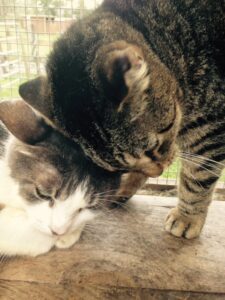
I especially enjoy practicing Tellington TTouch® on cats at the shelter as it gives me an opportunity to use my skills in a place where there are so many different cats with so many different issues, both behavioral and health related. More importantly, it can also mean the difference between a cat spending his life in the shelter or getting adopted, and having the chance of a new start as a loved and cherished pet. I am also fortunate to have a cage-free, no-kill shelter in my county which offers hospice care to aging and dying cats.
Tellington TTouch® offers a gentle form of bodywork consisting of circles, lifts and strokes. There are over 20 different TTouches that use different parts of the hands and fingers. There are also TTouches for different parts of the body such as the ears, mouth, tail and paws.
The standard circular TTouch is called the Clouded Leopard. This is applied by gently curving the fingers and using the pads to push the skin around in a small (1⁄2 inch to 1 inch in diameter), clockwise, one-and-a-quarter circle. Imagine a clock on your animal’s body and move the skin from six on the clock all the way round until you reach six on the clock again, and then go on to eight or nine on the clock. Keep your wrist straight yet flexible and off the body. Breathe calmly and rhythmically and keep your fingers, hand, arm and shoulder relaxed. If possible, place your other hand on the cat’s body to form a better connection. With cats, it is often best to place the fingers a little apart and allow each finger to make its own circle. We use a very light pressure with cats, equivalent to a comfortable pressure on your eyelid. The Clouded Leopard TTouch can be used to calm your cat on the way to the vet or in the vet’s waiting room, as well as to reduce stress and nervousness.
The basic TTouches are the same for all animals including humans. The only real difference is that cats are incredibly sensitive creatures and, therefore, one’s attention to pressure (so that it does not become too heavy) is of paramount importance, as is the cat’s body language. For example, a wagging tail is not a sign of happiness as it may be in a dog. Rather, it is a signal that the cat may be feeling overloaded. Cats can get overstimulated very quickly as many owners will already know. Cats are well-known for suddenly striking out when they are being petted (a.k.a. petting and biting syndrome) so we often give them short breaks during a session to process the TTouches. If you continue until a cat hisses, you have gone way too far. Less is definitely more with cats. Also, cats do not like to be restrained so being able to touch a cat you do not know can take a little time. I often find that playing, or feeding a few treats or some favorite food can be a good way to introduce myself before beginning a session.
Cats are responsive to different textures so we use a lot of different fabrics, such as sheepskin, towels or a soft cloth to diffuse our contact, as well as feathers, brushes, pointed paintbrushes or make-up brushes to give them a different experience. It is also important to note that cats often show changes in their behavior after a session rather than during a session, which you more often see with dogs and other animals.
Case Study: Milton
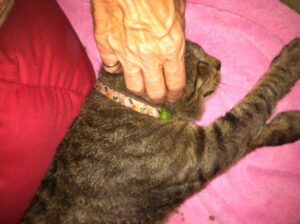
Milton was rescued in North Florida and brought to Domino’s House Cat Rescue League, Palm City, Florida in August 2013. He had been found blind and hungry wandering in the neighborhood where his former owner, an elderly woman, once lived. She had died about a year before and he had been thrown out to fend for himself. He tested positive for feline immunodeficiency virus and was neutered on his arrival. He would usually strike out if someone tried to touch him and, perhaps not surprisingly, was defensive around food.
The first time I saw Milton he was lying in a crate with his body hunched up in his litter tray surrounded by urine. He looked a sorry sight. Both his eyes were clouded over with cataracts and his ears has been badly damaged from cat fights. He was not moving and appeared to be in a state of shock.
I turned off the music to quieten the atmosphere and opened the door to allow some fresh air into the room. I began working with the two other cats nearby who were friendly so Milton could get accustomed to my presence and perhaps sense the other cats relaxing. I then began speaking very softly to Milton, a technique which we call “toning,” which I felt was very important as he could not see me. He did not move so I sat down on the floor next to his crate and continued toning so he could get used to my voice. I put a long feather through the bars of the cage and began stroking the top of his head, around his ears and shoulders. Cats usually like to be touched on these areas of their bodies so it is a good place to begin. I then stroked the feather against his whiskers. Cats and dogs often like to be touched here and find it calming and soothing. After a few minutes, I gave Milton a break to allow his body to integrate what I had done, then worked a little more gradually building up the duration. Within a short while I was able to stroke down his back and round the sides of his body, and then began doing circular movements with the feather. I proceeded to use two different kinds of feathers in the same way to give him different experiences and to gently begin to stimulate his body.
After another break, I put a sheepskin attached to a stick through the bars of the cage and began stroking him with it. I then opened the cage door and repeated what I had done. Milton still did not move. Encouraged that he had not tried to strike me and sensing he was relaxing, I put on a large padded glove and approached him very slowly. I began stroking him very gently with the back of the glove. We always prefer to begin contact by using the hands with the back of the hand or fingers – a touch we call the Llama TTouch – rather than starting with the Clouded Leopard or any other TTouch. This can be in either a stroking or one-and-a-quarter circle motion. I did a couple of strokes and then stopped. Milton began to accept the touch and gently pushed his head into the glove. I felt I had made a connection with him. This first session lasted about an hour.
Having made good progress I decided to continue the next day. When I arrived Milton was in exactly the same place in the same posture. I repeated what I had done the day before but was able to do it in less time. When I started to use the sheepskin on a stick he seemed to enjoy the feel of it and sat up, moved around and then sat down again. He repeated this four or five times. I sat back and wondered if he was ready for me to use my hand without the glove. I was a little unsure and felt he needed something to help him feel more relaxed and confident before I could do this. I decided to use a wrap, in this case some soft felt-like fabric cut into a 2½-inch by 4½-feet wide strip. I used my gloved hand to gently place the fabric over Milton’s body. I felt him begin to relax so I started using the sheepskin on a stick to stroke his head. I gently moved my hand (without the glove on it) down the stick and touched him with the back of one finger, then two and then three, withdrawing my fingers and going back to just using the sheepskin in between.
Working with all animals takes a lot of patience and while TTouching we always move in very small increments, and on their terms. If something is too much for them then we move back to what we were doing before. We allow the animal to guide us in the work. This way they feel more in control which helps them to become more confident and able to trust. We allow the animal to usher us in, and if we pay attention they can become our greatest teachers. How would you feel if, the next time you went to the dentist, he tied you in the chair and ignored your requests? It takes more time but is much more effective in the long term, and, in my opinion, is the only ethical way to be with animals.
My sessions with Milton continued over the next few weeks during which time I was able to touch him all over, using a whole array of different TTouches. After session six he was allowing the other volunteers to pet him and after session seven, he was allowed out of his cage and to roam freely with the five other cats in his enclosure. Milton continued to improve and became one of the most sociable and loved cats in the shelter. Whenever I went to see him he would come over for his special TTouches. He would even let me work with him whilst he was eating. There was never any indication of defensive or feral behavior, and Milton became in every way like a domestic cat.
Case Study: Teddy
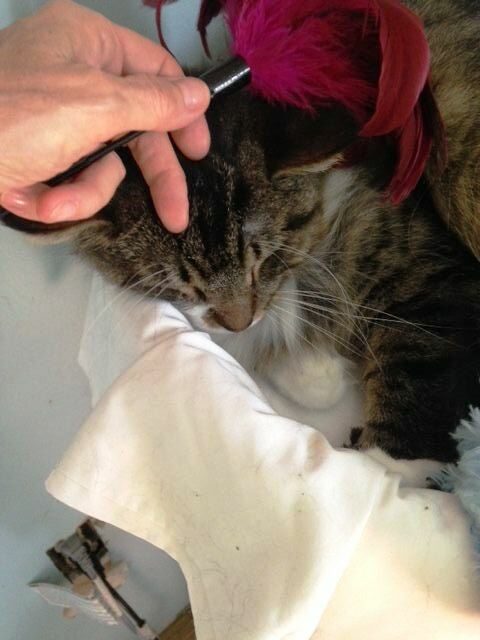
make the transition
Teddy is a neutered male aged around three years. He was born at Domino’s House and adopted as a kitten but returned to the shelter because they said he was not friendly. Being a sensitive cat, Teddy withdrew into himself and had become scared and defensive. The only person who could touch him was Maris, the rescue’s founder and owner.
Thinking I could use Maris as a bridge of connection, I asked her if she would introduce me to Teddy on my next visit. When we walked into the room he was crouching between the wall and a cage. Maris took hold of Teddy and I suggested we quickly wrap him in a towel. At first he was not very happy about this but gradually began to calm down. I started toning to Teddy and speaking softly to Maris, explaining how and where to touch him. She began gently touching his head, shoulders and sides with the back of her fingers (Llama TTouch) and then did some light, gentle strokes with a relaxed hand over the same areas. I then began touching Maris’s arm so Teddy could see I was not a threat and to build a connection through Maris. All the time I was using eye signals, slowly blinking and looking away to calm Teddy down.
Norwegian dog trainer, Turid Rugaas has identified about 30 different signals that dogs use to calm themselves and others, like a language of appeasement. Other animals and humans use many of these signals. If you observe your cat you will notice he does not blink when he is scared or alert, but when he is content or trying to slow you down, he will blink and partially close his eyes. If you respond by slowly closing your eyes, it seems to acknowledge and accept his effort to connect. Often cats will blink again and they may now look at you with softer eyes. Sometimes glancing away and/or slightly turning your head after the blink can be useful too. This tool is especially beneficial when working with scared or feral cats, or any cat that is nervous or frightened of being touched.
After a short while I began touching Teddy with the Llama TTouch over the towel, on his shoulders and body, and then on his head while Maris held him in the towel. Maris and I continued to work with him in this way for about 15 minutes and then decided it was enough for the first session.
Maris told me that when she went into the room later that day, Teddy was sitting on top of the cat furniture and did not run away, which had never happened before.
When I arrived for Teddy’s next session a week later he was again sitting up on top of the cat furniture. I began by blinking at him and after several blinks he blinked back. His whole demeanor had become more relaxed. I then approached him really slowly, the whole time blinking, looking away and licking my lips which is another useful calming signal. Over about seven minutes in a relaxed posture, I moved from outside the screen door of his room to where he was sitting, which was a distance of about 3 feet. I find the longer I take to introduce myself and allow the cat to get used to my presence, the quicker he will learn to trust me.
I then very slowly approached Teddy with feathers on a stick and began to stroke his head with them. He did not move, and after a while began to close his eyes. I very gradually moved closer. Still stroking him with the feathers, I began to move my hand further up the stick and then slipped in a touch with the back of my index finger, then two fingers, then the back of all my fingers. I kept stroking him this way with my fingers and intermittently with the feathers. Then I put the stick with the feathers very quietly down and was able to touch him with just the back of my fingers (Llama TTouch).
I turned my hand over and slowly began to do some Clouded Leopard TTouches on the top of Teddy’s head and then on his shoulders. He gave a big sigh, curled up, put his head down and closed his eyes. I began to gently stroke his left ear with my thumb following the shape of the ear from the base to the tip and then his right ear doing the same. Then, with the back of my hand, I stroked his whiskers against his face. He was looking very relaxed now so I began doing Clouded Leopard TTouches on his shoulders again and then moved further down his body. It is always important to go back to where the animal feels safe before moving to a place where he might feel less safe. Within a minute or so I was able to go halfway down his body. I felt I had already won a good level of trust with him. He seemed almost asleep now so I thought I would leave quietly and allow him to process the work.
During the next session I was able to keep touching Teddy despite the noise of workmen outside. The following day, Maris said Teddy was doing much better and was now jumping off his kitty condo to greet her when she went into his room, making a little meow sound as if to say, “Hello.” Teddy is now fully socialized. He even jumps down and rolls on his back whilst I stroke him.
Hair slides are one of the TTouches that Teddy and most medium- to long-haired cats enjoy, and a slightly different version can be used with short-haired cats. Take a small bunch of hair gently between your thumb and index finger and slowly slide up the hair from the roots to the tips at approximately a 90-degree angle to the roots. Hair slides are a wonderful way to introduce a cat to grooming or for a cat that dislikes to be brushed. The Hair Slides are also useful for activating circulation, reducing tension and calming highly strung or hyperactive cats.
Case Study: Dimples
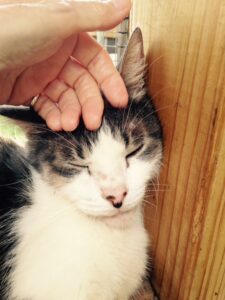
Dimples is a 7-year-old short-haired female cat who has lived all her life at the shelter. When I began working with her she would let only one or two particular volunteers stroke her after they had fed her many treats. Dimples would spend her whole time crouched on a shelf high up on a wall and did not seem particularly sociable with the other cats.
I worked with Dimples once a week over several weeks, using blinking and feathers on a stick initially and eventually just my hand for many of the TTouches. After one session when I was able to TTouch her hindquarters and tail, both of which were very stiff, her whole demeanor changed. It appeared to me that a lot of tension, which had been locked up in these areas of her body, had now been released. The following week when I came to see Dimples she was walking around outside and behaving like a very sociable cat. She now has a gentleman friend named Scout who climbs into her enclosure every day to snuggle.
Case Study: Peaches
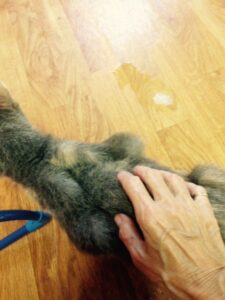
Peaches was brought to the shelter when she was 3 months old. She was found behind a fruit stand (hence her name) living as part of a feral colony. Peaches has been at Domino’s House for nine years now and although very socialized, has extremely bad skin allergies. She receives cortisone injections when needed.
The first time I began working with Peaches she was crouching down looking very uncomfortable. When I began touching her I could feel the skin on her entire body was crusty. Over several weeks, however, the TTouch has helped improve her appetite and increase her energy levels, and the skin on her tail and other parts of her body is now almost normal.
One of the TTouches I used with Peaches is the Ear TTouch. This is one of the most important TTouches as it can reduce stress, induce relaxation, improve digestion, boost the immune system and much more. Position yourself to the side and just behind your cat so you can support the head with one hand. Using the other hand, place your thumb on the outside of the ear and with your forefinger on the inner side, slide the finger and thumb from the base of the ear to the tip and repeat several times covering different portions of the ear with each slide.
By sharing these case study highlights my aim is to showcase some of the TTouches and techniques we use with cats, and to illustrate how they can be used successfully in a shelter environment. Hopefully they may also provide those working with cats another tool to consider when dealing with frightened, shy or unsocialized animals.
This article was first published in BARKS from the Guild, January 2017, p. 52-55.
About the Author
Deirdre Chitwood is a certified Tellington TTouch® practitioner of companion animals and a member of Truly Dog Friendly Training. She has a private practice, Tender Touch in Stuart, Florida where she lives with her husband and five cats. She offers workshops around the country as well as hosting regular workshops at her local cat shelter where she also volunteers. She studied the Tellington Method two-year Practitioner Certification Program in Chapel Hill, North Carolina and the UK. and has been privileged to assist Linda Tellington-Jones in workshops.

